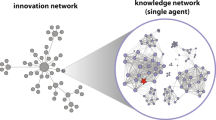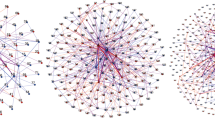Abstract
Cooperative knowledge creation among enterprises is becoming increasingly common in uncertain environments with rapidly changing technology and increasingly complex network relationships. The objective of this paper is to better understand why and how an uncertain network environment affects an enterprise’s knowledge creation performance and knowledge creation decision-making based on a dynamic knowledge supernetwork. Regarding the methodology, we proposed a dynamic knowledge supernetwork model that contains an enterprise subnetwork and a knowledge subnetwork, constructed the knowledge creation and knowledge diffusion mechanisms, and simulated the process of knowledge creation and diffusion through a multi-agent simulation. Moreover, we utilized the empirical patent data of power technology to prove the rationality and effectiveness of our model and simulation results. The results involve three main aspects. First, knowledge performance shows an exponential growth pattern. Second, in the dynamic network, we obtain a U-shaped relationship only when the effort needed to establish new cooperation is relatively small, and the inverted U-shaped relationship disappears when the above parameter exceeds a certain threshold. Third, the knowledge-based cooperation strategy is superior to the network-based cooperation strategy, and knowledge performance increases linearly and decreases exponentially with increasing network dynamics when the effort needed to establish new cooperation does not exceed and exceeds the threshold, respectively.










Similar content being viewed by others
References
Abramovsky, L., & Simpson, H. (2011). Geographic proximity and firm-university innovation linkages: Evidence from Great Britain. Journal of Economic Geography, 11(6), 949–977.
Aggarwal, C., & Subbian, K. (2014). Evolutionary network analysis: A survey. ACM Computing Surveys (CSUR), 47(1), 10.
Ahuja, G., & Katila, R. (2001). Technological acquisitions and the innovation performance of acquiring firms: A longitudinal study. Strategic Management Journal, 22(3), 197–220.
Alegre, J., & Chiva, R. (2008). Assessing the impact of organizational learning capability on product innovation performance: An empirical test. Technovation, 28(6), 315–326.
Baum, J. A., Cowan, R., & Jonard, N. (2010). Network-independent partner selection and the evolution of innovation networks. Management Science, 56(11), 2094–2110.
Boccaletti, S., Bianconi, G., Criado, R., Del Genio, C. I., Gómez-Gardenes, J., Romance, M., et al. (2014). The structure and dynamics of multilayer networks. Physics Reports, 544(1), 1–122.
Boone, T., Ganeshan, R., & Hicks, R. L. (2008). Learning and knowledge depreciation in professional services. Management Science, 54(7), 1231–1236.
Brennecke, J., & Rank, O. (2017). The firm’s knowledge network and the transfer of advice among corporate inventors—A multilevel network study. Research Policy, 46(4), 768–783.
Cantner, U., & Rake, B. (2014). International research networks in pharmaceuticals: Structure and dynamics. Research Policy, 43(2), 333–348.
Clegg, S., Josserand, E., Mehra, A., & Pitsis, T. S. (2016). The transformative power of network dynamics: A research agenda. Organization Studies, 37(3), 277–291.
Cohen, W. M., & Levinthal, D. A. (1990). Absorptive capacity: A new perspective on learning and innovation. Administrative Science Quarterly, 35, 128–152.
Cowan, R., & Jonard, N. (2004). Network structure and the diffusion of knowledge. Journal of economic Dynamics and Control, 28(8), 1557–1575.
De Prato, G., & Nepelski, D. (2014). Global technological collaboration network: Network analysis of international co-inventions. The Journal of Technology Transfer, 39(3), 358–375.
Ding, X. H., & Huang, R. H. (2010). Effects of knowledge spillover on inter-organizational resource sharing decision in collaborative knowledge creation. European Journal of Operational Research, 201(3), 949–959.
Duncan, R. B. (1972). Characteristics of organizational environments and perceived environmental uncertainty. Administrative Science Quarterly, 17(3), 313–327.
Eslami, H., Ebadi, A., & Schiffauerova, A. (2013). Effect of collaboration network structure on knowledge creation and technological performance: The case of biotechnology in Canada. Scientometrics, 97(1), 99–119.
Giuliani, E. (2013). Network dynamics in regional clusters: Evidence from Chile. Research Policy, 42(8), 1406–1419.
Guan, J., & Liu, N. (2016). Exploitative and exploratory innovations in knowledge network and collaboration network: A patent analysis in the technological field of nano-energy. Research Policy, 45(1), 97–112.
Helleboogh, A., Vizzari, G., Uhrmacher, A., & Michel, F. (2007). Modeling dynamic environments in multi-agent simulation. Autonomous Agents and Multi-Agent Systems, 14(1), 87–116.
Hill, C. W., & Rothaermel, F. T. (2003). The performance of incumbent firms in the face of radical technological innovation. Academy of Management Review, 28(2), 257–274.
Hillman, A. J., Withers, M. C., & Collins, B. J. (2009). Resource dependence theory: A review. Journal of Management, 35(6), 1404–1427.
Hong, J. F. L., Snell, R. S., & Easterby-Smith, M. (2009). Knowledge flow and boundary crossing at the periphery of a MNC. International Business Review, 18(6), 539–554.
Huang, A. Q., Crow, M. L., Heydt, G. T., Zheng, J. P., & Dale, S. J. (2011). The future renewable electric energy delivery and management (FREEDM) system: The energy internet. Proceedings of the IEEE, 99(1), 133–148.
Ioannidis, E., Varsakelis, N., & Antoniou, I. (2018). Communication policies in knowledge networks. Physica A: Statistical Mechanics and its Applications, 492, 360–374.
Isaksson, O. H., Simeth, M., & Seifert, R. W. (2016). Knowledge spillovers in the supply chain: Evidence from the high tech sectors. Research Policy, 45(3), 699–706.
Jaffe, A. B., Trajtenberg, M., & Henderson, R. (1993). Geographic localization of knowledge spillovers as evidenced by patent citations. The Quarterly Journal of Economics, 108(3), 577–598.
Kim, H., & Park, Y. (2009). Structural effects of R&D collaboration network on knowledge diffusion performance. Expert Systems with Applications, 36(5), 8986–8992.
Lhuillery, S., & Pfister, E. (2009). R&D cooperation and failures in innovation projects: Empirical evidence from French CIS data. Research Policy, 38(1), 45–57.
Lin, M., & Li, N. (2010). Scale-free network provides an optimal pattern for knowledge transfer. Physica A: Statistical Mechanics and its Applications, 389(3), 473–480.
Liu, J. G., Yang, G. Y., & Hu, Z. L. (2014a). A knowledge generation model via the hypernetwork. PLoS ONE, 9(3), e89746.
Liu, Y., Li, Q., Tang, X., Ma, N., & Tian, R. (2014b). Superedge prediction: What opinions will be mined based on an opinion supernetwork model? Decision Support Systems, 64, 118–129.
Liu, Y., Rafols, I., & Rousseau, R. (2012). A framework for knowledge integration and diffusion. Journal of Documentation, 68(1), 31–44.
Luo, S., Du, Y., Liu, P., Xuan, Z., & Wang, Y. (2015). A study on coevolutionary dynamics of knowledge diffusion and social network structure. Expert Systems with Applications, 42(7), 3619–3633.
McKendrick, D., Doner, R. F., & Haggard, S. (2000). From silicon valley to Singapore: Location and competitive advantage in the hard disk drive industry. Redwood City: Stanford Business Books.
Meagher, K., & Rogers, M. (2004). Network density and R&D spillovers. Journal of Economic Behavior and Organization, 53(2), 237–260.
Nam, Y., & Barnett, G. A. (2011). Globalization of technology: Network analysis of global patents and trademarks. Technological Forecasting and Social Change, 78(8), 1471–1485.
Orman, G. K., Labatut, V., & Naskali, A. T. (2017). Exploring the evolution of node neighborhoods in Dynamic Networks. Physica A: Statistical Mechanics and its Applications, 482, 375–391.
Perry-Smith, J. E., & Shalley, C. E. (2003). The social side of creativity: A static and dynamic social network perspective. Academy of Management Review, 28(1), 89–106.
Porter, C. M., & Woo, S. E. (2015). Untangling the networking phenomenon: A dynamic psychological perspective on how and why people network. Journal of Management, 41(5), 1477–1500.
Powell, W. W., Koput, K. W., & Smith-Doerr, L. (1996). Interorganizational collaboration and the locus of innovation: Networks of learning in biotechnology. Administrative Science Quarterly, 41(1), 116–145.
Powell, W. W., White, D. R., Koput, K. W., & Owen-Smith, J. (2005). Network dynamics and field evolution: The growth of interorganizational collaboration in the life sciences. American Journal of Sociology, 110(4), 1132–1205.
Qiu, J., Wang, Z., & Nian, C. (2014). An approach to filling firms’ knowledge gaps based on organisational knowledge structure. Journal of Knowledge Management, 18(1), 1–18.
Rojo, R., & Gómez, I. (2006). Analysis of the Spanish scientific and technological output in the ICT sector. Scientometrics, 66(1), 101–121.
Samaddar, S., & Kadiyala, S. S. (2006). An analysis of interorganizational resource sharing decisions in collaborative knowledge creation. European Journal of Operational Research, 170(1), 192–210.
Shou, Y., & Sun, Y. (2010). Modeling and simulation of knowledge transfer within an inter-firm network. In Information science and management engineering (ISME), 2010 international conference of (Vol. 2, pp. 99–103). IEEE.
Sun, Y., Lu, Y., Wang, T., Ma, H., & He, G. (2008). Pattern of patent-based environmental technology innovation in China. Technological Forecasting and Social Change, 75(7), 1032–1042.
Suo, Q., Sun, S., Hajli, N., & Love, P. E. (2015). User ratings analysis in social networks through a hypernetwork method. Expert Systems with Applications, 42(21), 7317–7325.
Tang, F. (2011). Knowledge transfer in intra-organization networks. Systems Research and Behavioral Science, 28(3), 270–282.
Tang, J., Scellato, S., Musolesi, M., Mascolo, C., & Latora, V. (2010). Small-world behavior in time-varying graphs. Physical Review E, 81(5), 055101.
Tian, R. Y., & Liu, Y. J. (2014). Isolation, insertion, and reconstruction: Three strategies to intervene in rumor spread based on supernetwork model. Decision Support Systems, 67, 121–130.
Tian, R. Y., Zhang, X. F., & Liu, Y. J. (2015). SSIC model: A multi-layer model for intervention of online rumors spreading. Physica A: Statistical Mechanics and its Applications, 427, 181–191.
Todo, Y., Matous, P., & Inoue, H. (2016). The strength of long ties and the weakness of strong ties: Knowledge diffusion through supply chain networks. Research Policy, 45(9), 1890–1906.
Todorova, G., & Durisin, B. (2007). Absorptive capacity: Valuing a reconceptualization. Academy of Management Review, 32(3), 774–786.
Tolstoy, D. (2009). Knowledge combination and knowledge creation in a foreign-market network. Journal of Small Business Management, 47(2), 202–220.
Tsai, W. (2001). Knowledge transfer in intraorganizational networks: Effects of network position and absorptive capacity on business unit innovation and performance. Academy of Management Journal, 44(5), 996–1004.
Von Hippel, E. (1994). “Sticky information” and the locus of problem solving: Implications for innovation. Management Science, 40(4), 429–439.
Wang, C., Rodan, S., Fruin, M., & Xu, X. (2014). Knowledge networks, collaboration networks, and exploratory innovation. Academy of Management Journal, 57(2), 484–514.
Wang, G., Liu, Y., Li, J., Tang, X., & Wang, H. (2015a). Superedge coupling algorithm and its application in coupling mechanism analysis of online public opinion supernetwork. Expert Systems with Applications, 42(5), 2808–2823.
Wang, J. P., Guo, Q., Yang, G. Y., & Liu, J. G. (2015b). Improved knowledge diffusion model based on the collaboration hypernetwork. Physica A: Statistical Mechanics and its Applications, 428, 250–256.
Wang, L., Yeung, J. H. Y., & Zhang, M. (2011). The impact of trust and contract on innovation performance: The moderating role of environmental uncertainty. International Journal of Production Economics, 134(1), 114–122.
Watts, D. J., & Strogatz, S. H. (1998). Collective dynamics of ‘small-world’ networks. Nature, 393(6684), 440–442.
Williamson, O. E. (2007). The economic institutions of capitalism. Firms, markets, relational contracting. In C. Boersch & R. Elschen (Eds.), Das Summa Summarum des management (pp. 61–75). Gabler.
Wu, J. (2011). Asymmetric roles of business ties and political ties in product innovation. Journal of Business Research, 64(11), 1151–1156.
Xuan, Z., Xia, H., & Du, Y. (2011). Adjustment of knowledge-connection structure affects the performance of knowledge transfer. Expert Systems with Applications, 38(12), 14935–14944.
Yang, G. Y., Hu, Z. L., & Liu, J. G. (2015). Knowledge diffusion in the collaboration hypernetwork. Physica A: Statistical Mechanics and its Applications, 419, 429–436.
Zamzami, N., & Schiffauerova, A. (2017). The impact of individual collaborative activities on knowledge creation and transmission. Scientometrics, 111(3), 1385–1413.
Zhang, H., Wu, W., & Zhao, L. (2016). A study of knowledge supernetworks and network robustness in different business incubators. Physica A: Statistical Mechanics and its Applications, 447, 545–560.
Zhao, L., Zhang, H., & Wu, W. (2017). Knowledge service decision making in business incubators based on the supernetwork model. Physica A: Statistical Mechanics and its Applications, 479, 249–264.
Acknowledgements
This work was supported by the National Social Science Foundation of China (Grant No. 17BGL025). The authors are grateful to an anonymous referee for instructive comments that improved this paper.
Author information
Authors and Affiliations
Corresponding author
Rights and permissions
About this article
Cite this article
Zhao, L., Zhang, H. & Wu, W. Cooperative knowledge creation in an uncertain network environment based on a dynamic knowledge supernetwork. Scientometrics 119, 657–685 (2019). https://doi.org/10.1007/s11192-019-03049-4
Received:
Published:
Issue Date:
DOI: https://doi.org/10.1007/s11192-019-03049-4
Keywords
- Cooperative knowledge creation
- Uncertain network environment
- Dynamic knowledge supernetwork
- Network dynamics
- Multi-agent simulation




